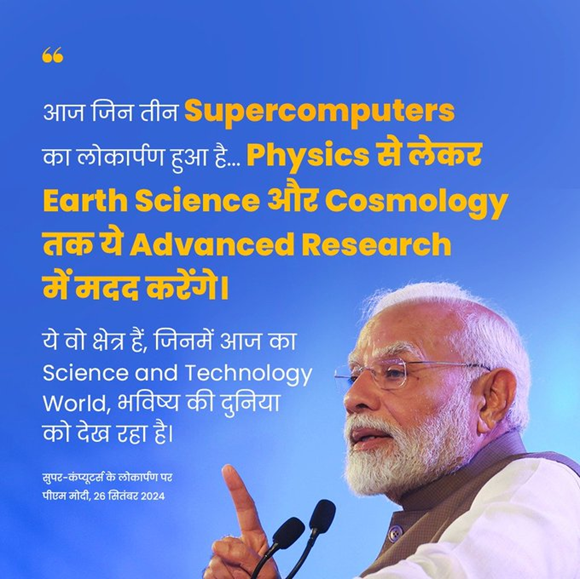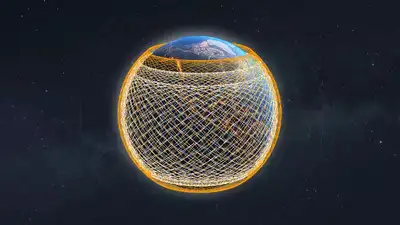- Courses
- GS Full Course 1 Year
- GS Full Course 2 Year
- GS Full Course 3 Year
- GS Full Course Till Selection
- CSAT
- 5 LAYERED ARJUNA Mentorship
- Public Administration Optional
- Online Program
- GS Recorded Course
- NCERT (Recorded 500+ Hours)
- Polity Recorded Course
- Geography Recorded Course
- Economy Recorded Course
- AMAC Recorded Course
- Modern India, Post Independence & World History
- Environment Recoded Course
- Governance Recoded Course
- Science & Tech. Recoded Course
- International Relations and Internal Security Recorded Course
- Disaster Management Module Course
- Ethics Recoded Course
- Essay Recoded Course
- Current Affairs Recoded Course
- ABOUT US
- OUR TOPPERS
- TEST SERIES
- FREE STUDY MATERIAL
- VIDEOS
- CONTACT US
PM Modi Dedicates 3 PARAM Rudra Supercomputers
PM Modi Dedicates 3 PARAM Rudra Supercomputers

On September 26, 2024, Prime Minister Narendra Modi dedicated three PARAM Rudra supercomputers, valued at around Rs 130 crore, via video conferencing. Developed under the National Supercomputing Mission (NSM), these supercomputers have been deployed in Pune, Delhi, and Kolkata to facilitate pioneering scientific research.
- The Prime Minister also inaugurated a High-Performance Computing (HPC) system tailored for weather and climate research.
Background
- Deployment: The three PARAM Rudra supercomputers are deployed at the Giant Metre Radio Telescope (GMRT) in Pune, Inter-University Accelerator Centre (IUAC) in Delhi, and S.N. Bose Centre in Kolkata, facilitating research across various scientific domains.
- Investment: The HPC system represents an investment of Rs 850 crore, reflecting India's commitment to advancing its computational capabilities for critical research applications.
Significance of the Dedication
- Achievement in Science and Technology: PM Modi highlighted the occasion as a major milestone for India's progress in science and technology, emphasizing the country’s commitment to research and development.
- Youth Empowerment: The supercomputers were dedicated to the youth, reflecting Modi's vision for advanced technology to be accessible to young scientists for research in physics, earth sciences, and cosmology.
PM Modi's Remarks
- Empowering Youth: The Prime Minister dedicated the supercomputers to the youth, highlighting their potential to advance research.
- Technological Advancements: He emphasized that the computing capacity is crucial for national capability in research, economic growth, and disaster management.
- Digital Revolution: He noted that India should not only match global standards but also serve humanity through scientific advancements, positioning India as a leader in technological innovations.
Advances in Various Sectors
- Space and Semiconductor Industries: PM Modi discussed India’s advancements, particularly in the space sector, noting the successful landing near the moon’s South Pole and future plans for the Gaganyaan Mission and an Indian space station by 2035.
- Semiconductors: He highlighted the launch of the India Semiconductor Mission to strengthen the semiconductor sector, a critical component in global supply chains.
Future Goals and Technologies
- Quantum Computing: PM Modi stated that India is taking the lead in quantum computing through the National Quantum Mission, which is expected to transform various sectors including IT, manufacturing, and startups.
- Impact of Supercomputers: He described how supercomputers will enable advanced research, particularly benefiting small farmers by providing access to crucial information on weather and soil, thereby improving decision-making for crop management and reducing risks for fishermen.
National Quantum Mission (NQM):
Key Goals
Focus Areas
Implementation Structure
Potential Impact
|
High-Performance Computing (HPC) System
- Infrastructure: The HPC system, located at the Indian Institute of Tropical Meteorology (IITM) in Pune and the National Center for Medium Range Weather Forecast (NCMRWF) in Noida, represents a substantial investment aimed at enhancing weather forecasting capabilities.
- Project Details: The HPC system, named 'Arka' and 'Arunika', will significantly improve predictions for tropical cyclones, heavy precipitation, and other weather phenomena.
Supercomputers in IndiaBackground: India's supercomputing program was initiated after the U.S. denied a request for the Cray X-MP in 1987. Key Agencies Involved
PARAM Series
Current Supercomputers
National Supercomputing Mission (NSM)
|
Conclusion
PM Modi concluded by congratulating citizens on these achievements and encouraging young researchers to leverage the new advanced facilities. The PARAM Rudra supercomputers and HPC systems signify a transformative leap in India’s scientific and technological landscape, with the potential to greatly impact everyday lives and strengthen national capabilities.
Must Check: Best IAS Coaching In Delhi
UPSC Prelims Result 2024 Out: Expected Cut Off & Other Details, UPSC Prelims 2024 Answer with Explanation, Daily Prelims Quiz, Daily Current Affairs, MONTHLY CURRENT AFFAIRS TOTAL (CAT) MAGAZINE, Best IAS Coaching Institute in Karol Bagh, Best IAS Coaching Institute in Delhi, Daily Mains Question Answer Practice, ENSURE IAS UPSC Toppers, UPSC Toppers Marksheet, Previous Year Interview Questions, UPSC Syllabus




